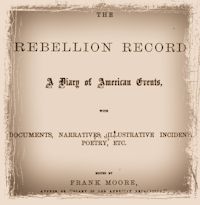November 18.—The firing on Fort Sumter from the National batteries continued. A rebel mortar battery on Sullivan’s Island shelled Gregg and the Cummings Point defences all day.— General Longstreet made an attack upon the Union outposts, on the Kingston road, near Knoxville, Tenn., and compelled General Sanders, in command of the forces there, to fall back to the town.—Doc. 19.
—General Averill arrived at New-Creek, Va. At or near Covington he encountered and dispersed a portion of Imboden’s command on their way to reenforce Echols, and captured twenty-five prisoners in the skirmish.
—The cavalry belonging to the Union forces under the command of Brigadier-General J. C. Sullivan, sent out from Harper’s Ferry, Va., returned this day, having been up the Valley to near New-Market, fighting Gilmore’s and White’s commands at Mount Jackson, bringing in twenty-seven prisoners, two commissioned officers, ninety head of cattle, three four-horse teams, besides thirty tents and all the horses and equipage of the prisoners; the party was under the command of Colonel Bayard, of the Thirty-first Pennsylvania cavalry.
He destroyed a number of tents and a quantity of salt. The men helped themselves to a wagon-load of tobacco, weighing about five hundred pounds.
The Union loss was two men killed, three wounded and three missing. — General Sullivan’s Despatch.
—Corpus Christi and Aranzas Pass, Texas, were captured by the National forces under the command of Major-General Banks. Yesterday afternoon at about three o’clock, the gunboat Monongahela, with a fleet of nine vessels, transports, etc., arrived at the bar and commenced landing troops through the surf on the south point of Mustang Island. This morning at sunrise, the Thirteenth and Fourteenth Maine regiments, Thirty-fourth Iowa, Eighth Indiana, and company F, First Missouri artillery, with a part of the Twentieth Iowa volunteers, were ashore and in column en route up the beach toward Aranzas Pass. About eleven o’clock the Monongahela opened her two hundred-pound Parrott on the enemy’s battery, which was planted behind the sand-hills so as to completely cover the channel and southern point of St. Joseph’s Island. In the mean time the Thirteenth and Fourteenth Maine, the two advance regiments, succeeded in getting in the rear of the works within two miles, without being discovered. The armed transport McClellan, Captain Gray, drawing less water than the Monongahela, worked up close on to the battery, soon making it untenable. They abandoned the battery, sought shelter from the sand-hills, until their flag of truce was discovered, when they were permitted to surrender without terms. Their battery consisted of three twenty-four-pounders and one eight-inch sea-howitzer. The force of the garrison consisted of one company of regular artillery and two companies of drafted Texan militia, in all, about one hundred and fifty men.



